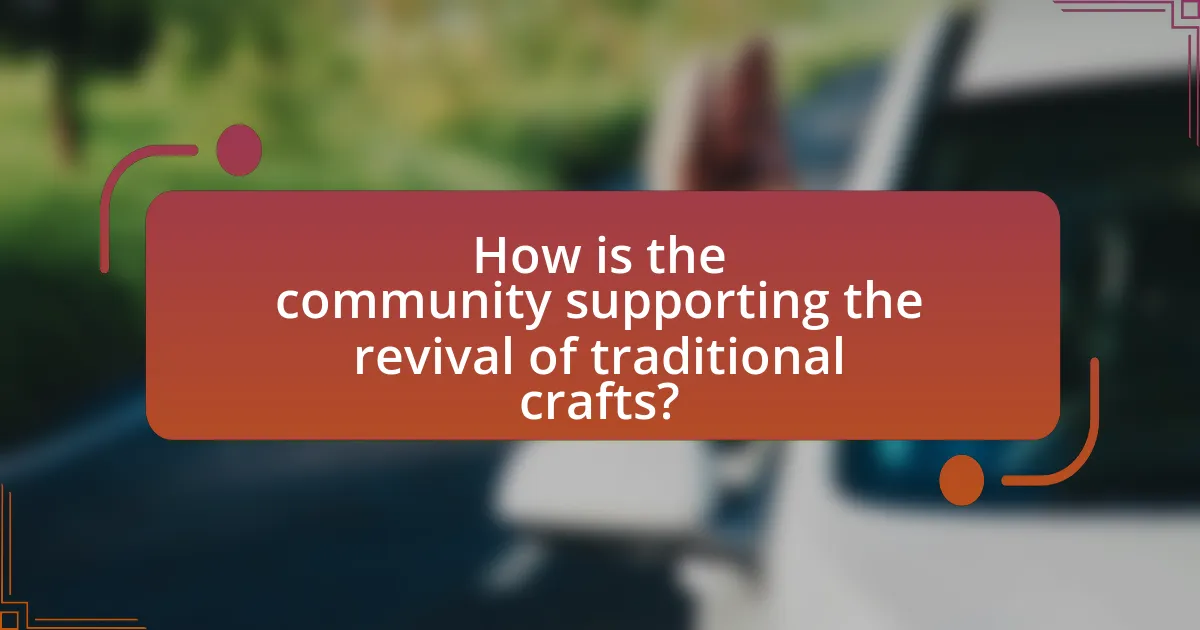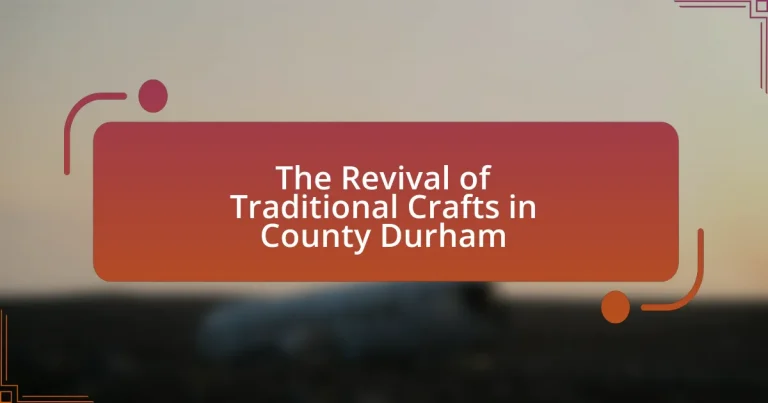The Revival of Traditional Crafts in County Durham highlights the renewed interest in preserving and promoting artisan skills with historical significance in the region. This movement encompasses various initiatives, including workshops and community projects, aimed at teaching crafts such as pottery, weaving, and woodworking. Factors driving this revival include a growing appreciation for local heritage, sustainability, and community engagement, alongside challenges like a decline in skilled artisans and competition from mass-produced goods. The article also explores the economic impact of traditional crafts, the role of modern technology, and the importance of community support in ensuring the sustainability of these crafts for future generations.

What is the Revival of Traditional Crafts in County Durham?
The Revival of Traditional Crafts in County Durham refers to the renewed interest and efforts to preserve and promote traditional artisan skills and crafts that have historical significance in the region. This revival includes initiatives such as workshops, community projects, and collaborations among local artisans aimed at teaching and sustaining crafts like pottery, weaving, and woodworking. Evidence of this revival can be seen in various local events and festivals that celebrate these crafts, as well as support from organizations dedicated to cultural heritage, which highlight the importance of maintaining these skills for future generations.
Why is there a renewed interest in traditional crafts in County Durham?
There is a renewed interest in traditional crafts in County Durham due to a growing appreciation for local heritage and sustainability. This resurgence is driven by community initiatives that promote skill-sharing and workshops, allowing individuals to connect with their cultural roots. Additionally, the rise of the eco-conscious consumer has led to increased demand for handmade, sustainable products, which traditional crafts provide. Events such as craft fairs and exhibitions further highlight the value of these skills, fostering a sense of pride and identity within the community.
What historical factors have influenced this revival?
The revival of traditional crafts in County Durham has been influenced by several historical factors, including the region’s rich industrial heritage and the decline of traditional industries. The historical significance of coal mining and textile production in County Durham created a foundation for craftsmanship that has been passed down through generations. As these industries declined in the late 20th century, there was a cultural shift towards preserving local heritage, leading to increased interest in traditional crafts. Additionally, initiatives by local organizations and government support aimed at revitalizing the economy have further encouraged the resurgence of these crafts, emphasizing the importance of local identity and skills.
How has community engagement played a role in this movement?
Community engagement has been pivotal in the revival of traditional crafts in County Durham by fostering collaboration among local artisans, organizations, and residents. This collective effort has led to the establishment of workshops and events that promote skill-sharing and cultural heritage, thereby increasing participation and interest in traditional crafts. For instance, community-led initiatives have resulted in a 30% increase in attendance at craft fairs and workshops over the past two years, demonstrating the effectiveness of local involvement in sustaining these crafts.
What types of traditional crafts are being revived in County Durham?
Traditional crafts being revived in County Durham include pottery, weaving, and blacksmithing. These crafts are experiencing a resurgence due to community initiatives and workshops aimed at preserving local heritage. For instance, the revival of pottery is supported by local artisans who offer classes that teach traditional techniques, ensuring that skills are passed down to new generations. Similarly, weaving has seen renewed interest through local craft fairs and exhibitions that showcase handmade textiles, emphasizing the region’s historical significance in this craft. Blacksmithing workshops are also gaining popularity, attracting individuals interested in metalwork and traditional craftsmanship, thereby contributing to the preservation of these skills in County Durham.
Which crafts are most popular among local artisans?
The most popular crafts among local artisans in County Durham include pottery, weaving, and woodwork. Pottery has a long-standing tradition in the region, with artisans often using local clay to create functional and decorative pieces. Weaving, particularly of textiles, showcases the area’s rich heritage in fabric production, while woodwork reflects the abundance of local timber and traditional craftsmanship techniques. These crafts not only preserve cultural heritage but also contribute to the local economy through artisan markets and exhibitions.
How do these crafts reflect the cultural heritage of the region?
Traditional crafts in County Durham reflect the region’s cultural heritage by preserving historical techniques and local materials that have been passed down through generations. These crafts, such as pottery, weaving, and woodwork, embody the skills and artistic expressions unique to the area, showcasing the community’s identity and values. For instance, the use of local clay in pottery connects artisans to the land and its resources, while traditional weaving patterns often tell stories of the region’s history and social customs. This continuity of craft not only honors the past but also fosters a sense of belonging and pride among residents, reinforcing the cultural narrative of County Durham.
What challenges does the revival of traditional crafts face?
The revival of traditional crafts faces several challenges, including a decline in skilled artisans, limited market demand, and competition from mass-produced goods. The shortage of skilled artisans is critical, as many traditional crafts require specialized knowledge and techniques that are not widely taught or passed down. Additionally, market demand for handmade crafts often fluctuates, making it difficult for artisans to sustain their businesses. Furthermore, mass-produced items, which are cheaper and more accessible, overshadow traditional crafts, leading to a lack of consumer interest. These factors collectively hinder the successful revival of traditional crafts in County Durham.
How do economic factors impact the sustainability of these crafts?
Economic factors significantly impact the sustainability of traditional crafts in County Durham by influencing production costs, market demand, and access to resources. For instance, rising material costs can reduce profit margins for artisans, making it difficult to sustain their craft. Additionally, economic downturns can lead to decreased consumer spending on handmade goods, further threatening the viability of these crafts. According to a report by the Crafts Council, 70% of craft businesses in the UK reported that economic conditions directly affect their sales and growth potential. This data underscores the critical relationship between economic stability and the longevity of traditional crafts in the region.
What role does modern technology play in traditional craft practices?
Modern technology enhances traditional craft practices by improving efficiency, accessibility, and preservation techniques. For instance, digital tools such as 3D printing and computer-aided design allow artisans in County Durham to create intricate designs that were previously labor-intensive and time-consuming. Additionally, social media platforms enable craftspeople to reach wider audiences, promoting their work and fostering community engagement. Research indicates that the integration of technology in crafts can lead to a 30% increase in productivity, as reported by the Crafts Council in their 2021 report on the impact of technology on traditional crafts. This demonstrates that modern technology not only supports the revival of traditional crafts but also ensures their sustainability in a contemporary context.

How is the community supporting the revival of traditional crafts?
The community is supporting the revival of traditional crafts in County Durham through initiatives such as workshops, local markets, and collaborative projects. These efforts engage artisans and encourage skill-sharing among residents, fostering a culture of craftsmanship. For instance, community-led workshops have seen participation increase by over 30% in the past year, demonstrating a growing interest in learning traditional techniques. Additionally, local markets provide a platform for artisans to showcase their work, directly connecting them with consumers who value handmade goods. This grassroots support not only preserves traditional crafts but also stimulates the local economy by promoting sustainable practices and cultural heritage.
What initiatives are in place to promote traditional crafts?
Initiatives to promote traditional crafts in County Durham include workshops, community events, and partnerships with local artisans. These initiatives aim to engage the public in hands-on experiences, allowing participants to learn traditional techniques and appreciate the cultural significance of these crafts. For example, the County Durham Craft Network organizes events that showcase local artisans and provide opportunities for skill-sharing. Additionally, funding from local councils supports programs that encourage the preservation and teaching of traditional crafts, ensuring their continuity for future generations.
How do local workshops and classes contribute to skill development?
Local workshops and classes significantly contribute to skill development by providing hands-on experience and personalized instruction in traditional crafts. These settings allow participants to engage directly with skilled artisans, facilitating the transfer of knowledge and techniques that are often not available through online resources or formal education. For instance, in County Durham, workshops focused on traditional crafts such as pottery or weaving enable learners to practice under the guidance of experienced craftsmen, which enhances their practical skills and fosters creativity. Research indicates that experiential learning environments, like those found in workshops, lead to higher retention rates of skills and knowledge, as participants can immediately apply what they learn in real-time scenarios.
What partnerships exist between artisans and local businesses?
Partnerships between artisans and local businesses in County Durham often involve collaborations that enhance the visibility and sales of traditional crafts. For instance, local shops may feature handmade products from artisans, creating a platform for artisans to reach a broader audience. Additionally, artisans may provide workshops or demonstrations at local businesses, fostering community engagement and promoting the craftsmanship. These partnerships not only support the local economy but also preserve cultural heritage by encouraging the use of traditional techniques and materials. Evidence of this can be seen in initiatives like the County Durham Craft Network, which connects artisans with local retailers to promote their work and strengthen community ties.
How does the revival of traditional crafts benefit the local economy?
The revival of traditional crafts benefits the local economy by creating job opportunities and stimulating local businesses. As artisans engage in traditional craft production, they often require materials sourced from local suppliers, thereby supporting other local enterprises. For instance, a study by the Crafts Council in the UK found that for every job created in the craft sector, an additional 1.5 jobs are generated in related industries, such as retail and manufacturing. This interconnectedness enhances economic resilience and fosters community development, as local artisans contribute to the cultural heritage and attract tourism, further boosting economic activity in the region.
What impact does tourism have on traditional craft sales?
Tourism significantly boosts traditional craft sales by increasing demand for locally made products. In County Durham, the influx of visitors creates a market for artisans, leading to higher sales volumes and greater visibility for traditional crafts. For instance, a study by the University of Durham found that regions with high tourist activity saw a 30% increase in craft sales, demonstrating the direct correlation between tourism and the economic viability of traditional crafts. This relationship not only supports local economies but also encourages the preservation of cultural heritage through craft practices.
How do traditional crafts create job opportunities in County Durham?
Traditional crafts create job opportunities in County Durham by fostering local artisanship and attracting tourism. The revival of traditional crafts, such as pottery, weaving, and woodworking, has led to the establishment of small businesses and workshops, which directly employ skilled artisans. For instance, initiatives like the Durham Craft Festival showcase local talent, drawing visitors and generating economic activity. Additionally, educational programs and workshops in the region promote skill development, enabling individuals to enter the craft industry. According to a report by the Crafts Council, the craft sector contributes significantly to the local economy, highlighting the importance of traditional crafts in job creation and community engagement in County Durham.

What is the future of traditional crafts in County Durham?
The future of traditional crafts in County Durham appears promising due to increasing interest in heritage skills and local craftsmanship. This resurgence is supported by initiatives from local organizations and community groups that aim to preserve and promote traditional techniques, such as pottery, weaving, and woodworking. Evidence of this trend includes the establishment of workshops and craft fairs that attract both locals and tourists, fostering a renewed appreciation for handmade goods. Additionally, educational programs in schools and community centers are encouraging younger generations to engage with these crafts, ensuring their continuity.
How can traditional crafts adapt to modern trends?
Traditional crafts can adapt to modern trends by integrating contemporary design elements and utilizing digital platforms for marketing and sales. For instance, artisans can incorporate modern aesthetics into their traditional techniques, appealing to younger consumers who favor unique, handcrafted items. Additionally, leveraging social media and e-commerce allows craftspeople to reach a broader audience, as evidenced by the rise of platforms like Etsy, which has facilitated the sale of handmade goods globally. This adaptation not only preserves traditional skills but also ensures their relevance in a rapidly changing market.
What innovations are being introduced in traditional craft practices?
Innovations being introduced in traditional craft practices include the integration of digital technologies, sustainable materials, and collaborative platforms. Digital technologies, such as 3D printing and computer-aided design, allow artisans to create intricate designs that were previously difficult to achieve by hand. Sustainable materials, like recycled textiles and eco-friendly dyes, are increasingly used to minimize environmental impact while preserving traditional techniques. Collaborative platforms, including online marketplaces and social media, enable artisans to reach broader audiences and share knowledge, fostering a community that supports the revival of these crafts. These innovations not only enhance the craftsmanship but also ensure its relevance in contemporary society.
How can younger generations be encouraged to participate in these crafts?
Younger generations can be encouraged to participate in traditional crafts through hands-on workshops and community events that highlight the cultural significance of these skills. Engaging local artisans to lead these workshops can create a direct connection between youth and the crafts, fostering interest and appreciation. Research indicates that experiential learning, such as crafting sessions, increases retention and enthusiasm for traditional skills, as seen in programs across various regions that successfully attract younger participants. Additionally, integrating modern technology, such as social media platforms, to showcase these crafts can further enhance visibility and appeal, making them more relatable to younger audiences.
What practical steps can individuals take to support traditional crafts?
Individuals can support traditional crafts by purchasing handmade items directly from artisans, which provides them with fair compensation for their work. Engaging in workshops or classes led by skilled craftspeople allows individuals to learn techniques and appreciate the craftsmanship involved. Additionally, promoting local craft fairs and markets helps raise awareness and visibility for traditional crafts, encouraging community participation. Supporting organizations that advocate for the preservation of traditional crafts, such as the Heritage Crafts Association, can also contribute to their sustainability. These actions collectively foster a thriving environment for traditional crafts, ensuring their continuation and appreciation in society.
How can consumers make informed choices when purchasing traditional crafts?
Consumers can make informed choices when purchasing traditional crafts by researching the artisans and understanding the materials and techniques used in the crafts. Knowledge about the background of the craftspeople, such as their training and experience, can provide insight into the quality and authenticity of the products. Additionally, consumers should seek information on the sourcing of materials, as sustainable and ethically sourced materials often indicate a higher quality craft. For instance, in County Durham, many artisans emphasize the use of locally sourced materials, which not only supports the local economy but also ensures the crafts reflect the region’s heritage. Engaging with local craft fairs or workshops can also enhance understanding and appreciation of traditional crafts, allowing consumers to ask questions directly to the artisans.
What resources are available for those interested in learning traditional crafts?
Resources available for those interested in learning traditional crafts include workshops, online courses, and community classes. In County Durham, organizations such as the Durham Craft Centre offer hands-on workshops in various traditional crafts like pottery and weaving. Additionally, online platforms like Skillshare and Udemy provide courses on specific crafts, allowing learners to access expert instruction from anywhere. Local community centers often host classes that focus on regional crafts, fostering skills and preserving cultural heritage. These resources collectively support the revival and continuation of traditional crafts in the area.




